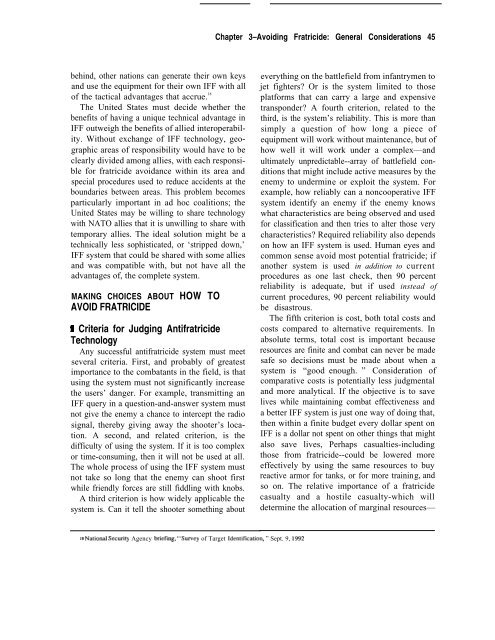Who Goes There: Friend or Foe? - Federation of American Scientists
Who Goes There: Friend or Foe? - Federation of American Scientists
Who Goes There: Friend or Foe? - Federation of American Scientists
You also want an ePaper? Increase the reach of your titles
YUMPU automatically turns print PDFs into web optimized ePapers that Google loves.
ehind, other nations can generate their own keys<br />
and use the equipment f<strong>or</strong> their own IFF with all<br />
<strong>of</strong> the tactical advantages that accrue. 18<br />
The United States must decide whether the<br />
benefits <strong>of</strong> having a unique technical advantage in<br />
IFF outweigh the benefits <strong>of</strong> allied interoperability.<br />
Without exchange <strong>of</strong> IFF technology, geographic<br />
areas <strong>of</strong> responsibility would have to be<br />
clearly divided among allies, with each responsible<br />
f<strong>or</strong> fratricide avoidance within its area and<br />
special procedures used to reduce accidents at the<br />
boundaries between areas. This problem becomes<br />
particularly imp<strong>or</strong>tant in ad hoc coalitions; the<br />
United States may be willing to share technology<br />
with NATO allies that it is unwilling to share with<br />
temp<strong>or</strong>ary allies. The ideal solution might be a<br />
technically less sophisticated, <strong>or</strong> ‘stripped down,’<br />
IFF system that could be shared with some allies<br />
and was compatible with, but not have all the<br />
advantages <strong>of</strong>, the complete system.<br />
MAKING CHOICES ABOUT HOW TO<br />
AVOID FRATRICIDE<br />
B Criteria f<strong>or</strong> Judging Antifratricide<br />
Technology<br />
Any successful antifratricide system must meet<br />
several criteria. First, and probably <strong>of</strong> greatest<br />
imp<strong>or</strong>tance to the combatants in the field, is that<br />
using the system must not significantly increase<br />
the users’ danger. F<strong>or</strong> example, transmitting an<br />
IFF query in a question-and-answer system must<br />
not give the enemy a chance to intercept the radio<br />
signal, thereby giving away the shooter’s location.<br />
A second, and related criterion, is the<br />
difficulty <strong>of</strong> using the system. If it is too complex<br />
<strong>or</strong> time-consuming, then it will not be used at all.<br />
The whole process <strong>of</strong> using the IFF system must<br />
not take so long that the enemy can shoot first<br />
while friendly f<strong>or</strong>ces are still fiddling with knobs.<br />
A third criterion is how widely applicable the<br />
system is. Can it tell the shooter something about<br />
18 Natio~ sec~~ Agency bfiefkg, “Smey <strong>of</strong> Target Identiflcatioq ” Sept. 9, 1992<br />
Chapter 3–Avoiding Fratricide: General Considerations 45<br />
everything on the battlefield from infantrymen to<br />
jet fighters? Or is the system limited to those<br />
platf<strong>or</strong>ms that can carry a large and expensive<br />
transponder? A fourth criterion, related to the<br />
third, is the system’s reliability. This is m<strong>or</strong>e than<br />
simply a question <strong>of</strong> how long a piece <strong>of</strong><br />
equipment will w<strong>or</strong>k without maintenance, but <strong>of</strong><br />
how well it will w<strong>or</strong>k under a complex—and<br />
ultimately unpredictable--array <strong>of</strong> battlefield conditions<br />
that might include active measures by the<br />
enemy to undermine <strong>or</strong> exploit the system. F<strong>or</strong><br />
example, how reliably can a noncooperative IFF<br />
system identify an enemy if the enemy knows<br />
what characteristics are being observed and used<br />
f<strong>or</strong> classification and then tries to alter those very<br />
characteristics? Required reliability also depends<br />
on how an IFF system is used. Human eyes and<br />
common sense avoid most potential fratricide; if<br />
another system is used in addition to current<br />
procedures as one last check, then 90 percent<br />
reliability is adequate, but if used instead <strong>of</strong><br />
current procedures, 90 percent reliability would<br />
be disastrous.<br />
The fifth criterion is cost, both total costs and<br />
costs compared to alternative requirements. In<br />
absolute terms, total cost is imp<strong>or</strong>tant because<br />
resources are finite and combat can never be made<br />
safe so decisions must be made about when a<br />
system is “good enough. ” Consideration <strong>of</strong><br />
comparative costs is potentially less judgmental<br />
and m<strong>or</strong>e analytical. If the objective is to save<br />
lives while maintaining combat effectiveness and<br />
a better IFF system is just one way <strong>of</strong> doing that,<br />
then within a finite budget every dollar spent on<br />
IFF is a dollar not spent on other things that might<br />
also save lives, Perhaps casualties-including<br />
those from fratricide--could be lowered m<strong>or</strong>e<br />
effectively by using the same resources to buy<br />
reactive arm<strong>or</strong> f<strong>or</strong> tanks, <strong>or</strong> f<strong>or</strong> m<strong>or</strong>e training, and<br />
so on. The relative imp<strong>or</strong>tance <strong>of</strong> a fratricide<br />
casualty and a hostile casualty-which will<br />
determine the allocation <strong>of</strong> marginal resources—
















